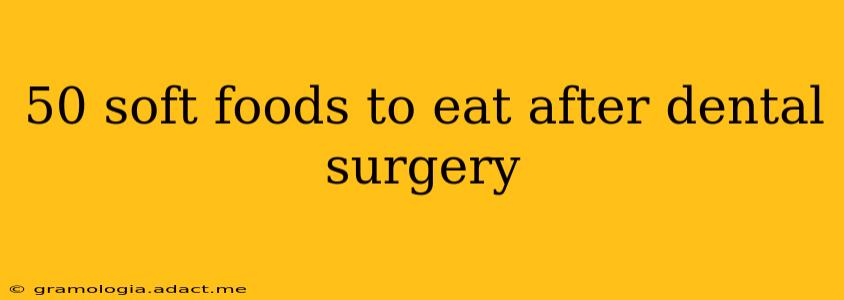50 Soft Foods to Eat After Dental Surgery: A Guide to Easy Eating & Healing
Recovering from dental surgery can be challenging, and one of the biggest hurdles is figuring out what to eat. Chewing can be painful, so a diet of soft, easily digestible foods is crucial for both comfort and healing. This comprehensive guide provides 50 soft food ideas to nourish your body during your recovery, ensuring you get the nutrients you need without putting unnecessary strain on your mouth.
Understanding Your Dietary Needs Post-Surgery
The type and extent of your dental procedure will influence your dietary needs. After a simple extraction, you might be able to transition to slightly firmer foods sooner than someone who's undergone extensive oral surgery. Always follow your dentist's specific instructions, which may vary depending on the procedure. In general, avoid foods that require excessive chewing, are acidic, or are highly seasoned, as these can irritate the surgical site.
Categorizing Soft Foods for Easy Navigation
To simplify your meal planning, we've categorized these 50 soft food options:
Breakfast Options:
- Oatmeal (cooked until very soft)
- Yogurt (plain or flavored, full-fat for better satiety)
- Scrambled eggs (well-cooked and smooth)
- Smoothies (fruit and vegetable-based, using soft fruits)
- Cream of Wheat
- Mashed Banana
- Applesauce (unsweetened is best)
- Breakfast Pudding (rice pudding, tapioca pudding)
- French toast (soaked well and cooked until soft)
- Pancakes (cooked well and soft)
Lunch & Dinner Options:
- Soup (broth-based, pureed, or with very soft vegetables)
- Mashed potatoes
- Sweet potatoes (mashed or baked until very soft)
- Mac and cheese (ensure pasta is very soft)
- Scrambled tofu
- Pureed vegetables (carrots, peas, squash)
- Lentils (cooked until very soft)
- Chicken noodle soup (noodle should be very soft)
- Cream of mushroom soup
- Refried beans
- Cottage cheese
- Avocado (mashed)
- Salmon (cooked until flaky and easily broken)
- Tuna salad (ensure tuna is well-mixed and not chunky)
- Pasta with creamy sauce (ensure pasta is very soft)
- Ground beef (very well-cooked and soft)
Snacks:
- Pudding (chocolate, vanilla, etc.)
- Jell-O
- Fruit popsicles (no chunks of fruit)
- Milkshakes
- Yogurt parfaits (with soft granola)
- Soft cheese (cream cheese, ricotta)
- Mashed chickpeas
- Hummus (with soft pita bread or crackers)
- Cooked carrots (very soft)
Drinks:
- Water (essential for healing)
- Smoothies (nutritious and hydrating)
- Milk (dairy or non-dairy)
- Broth (chicken, vegetable)
- Protein shakes
Other Options:
- Scrambled tofu
- Soft-boiled eggs (well-cooked)
- Well-cooked pasta (small shapes)
- Rice (cooked until soft)
- Quinoa (cooked until soft)
- Baked beans (well-cooked and soft)
- Soft cooked vegetables (peas, green beans)
- Oatmeal with fruit (pureed or very soft fruit)
- Yogurt with honey and cinnamon
- Ice cream (full-fat ice cream is better for calories and satiety)
Frequently Asked Questions (FAQs)
What should I avoid eating after dental surgery?
Avoid anything that requires vigorous chewing, is acidic (like citrus fruits or tomatoes), or is crunchy or hard. Spicy foods can also irritate the surgical site. Alcohol and smoking should also be avoided, as they hinder healing.
How long should I stick to a soft food diet after a tooth extraction?
The duration varies depending on the complexity of the surgery and your individual healing process. Your dentist will provide specific guidance; it can range from a few days to several weeks.
What if I'm struggling to eat enough calories on a soft food diet?
Consider adding full-fat options to boost calorie intake. Smoothies and milkshakes can be fortified with protein powder or nut butter. Consult your dentist or doctor if you have concerns about inadequate nutrition.
Can I eat anything that’s not on this list?
Always consult your dentist before adding any new food to your diet post-surgery. They can assess your healing progress and advise on appropriate food choices. Err on the side of caution—it’s better to stick to soft foods initially and gradually reintroduce others as your mouth heals.
Remember to listen to your body. If a food causes discomfort, stop eating it immediately. This guide is for informational purposes only and does not replace professional medical advice. Always follow your dentist’s specific recommendations.
